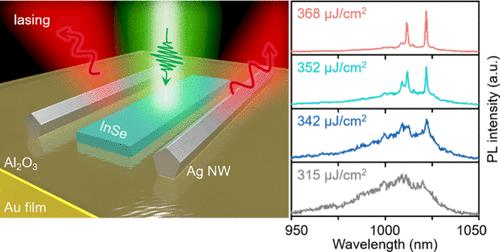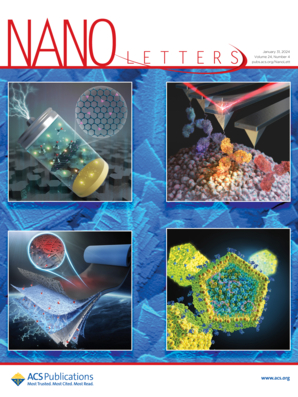Room-Temperature Two-Dimensional InSe Plasmonic Laser
IF 9.6
1区 材料科学
Q1 CHEMISTRY, MULTIDISCIPLINARY
引用次数: 0
Abstract
Two-dimensional (2D) semiconductors, owing to their strong excitonic emission, are emerging as efficient gain media for constructing the ultimate nanolaser. The further integration of 2D semiconductors with plasmonic devices holds promise for realizing the thinnest laser. However, the implementation of 2D semiconductor plasmonic lasing is severely hindered by the limited cavity feedback and low gain resulting from insufficient plasmon–exciton interactions. Here, we report the realization of a room-temperature 2D semiconductor plasmonic laser by embedding an InSe nanoflake into a plasmonic Fabry–Perot (F–P) cavity. This plasmonic F–P cavity shows an exceptional ability to recycle the leaked dark surface plasmon, resulting in >2-fold enhancement of feedback compared to that of conventional metal–insulator–semiconductor nanolasers. Moreover, via combination of field enhancement and orientation matching, this cavity facilitates optimized plasmon–exciton coupling to ensure sufficient gain for sustaining room-temperature lasing. Our work may open up the possibilities for multifunctional photonic devices based on 2D materials.

室温二维 InSe 等离子激光器
二维(2D)半导体因其强烈的激子发射,正在成为构建终极纳米激光器的高效增益介质。二维半导体与等离子器件的进一步集成有望实现最薄激光器。然而,二维半导体质子激光的实现受到腔反馈有限和质子-激子相互作用不足导致增益低的严重阻碍。在此,我们报告了通过将铟硒纳米片嵌入等离子法布里-珀罗(F-P)腔实现室温二维半导体等离子激光的情况。与传统的金属-绝缘体-半导体纳米激光器相比,这种质子法布里-珀罗腔具有回收泄漏的暗表面等离子体的特殊能力,从而使反馈增强了2倍。此外,通过场增强和取向匹配的结合,该空腔有助于优化等离子体-激子耦合,从而确保维持室温激光所需的足够增益。我们的工作可能会为基于二维材料的多功能光子器件开辟新的可能性。
本文章由计算机程序翻译,如有差异,请以英文原文为准。
求助全文
约1分钟内获得全文
求助全文
来源期刊

Nano Letters
工程技术-材料科学:综合
CiteScore
16.80
自引率
2.80%
发文量
1182
审稿时长
1.4 months
期刊介绍:
Nano Letters serves as a dynamic platform for promptly disseminating original results in fundamental, applied, and emerging research across all facets of nanoscience and nanotechnology. A pivotal criterion for inclusion within Nano Letters is the convergence of at least two different areas or disciplines, ensuring a rich interdisciplinary scope. The journal is dedicated to fostering exploration in diverse areas, including:
- Experimental and theoretical findings on physical, chemical, and biological phenomena at the nanoscale
- Synthesis, characterization, and processing of organic, inorganic, polymer, and hybrid nanomaterials through physical, chemical, and biological methodologies
- Modeling and simulation of synthetic, assembly, and interaction processes
- Realization of integrated nanostructures and nano-engineered devices exhibiting advanced performance
- Applications of nanoscale materials in living and environmental systems
Nano Letters is committed to advancing and showcasing groundbreaking research that intersects various domains, fostering innovation and collaboration in the ever-evolving field of nanoscience and nanotechnology.
 求助内容:
求助内容: 应助结果提醒方式:
应助结果提醒方式:


